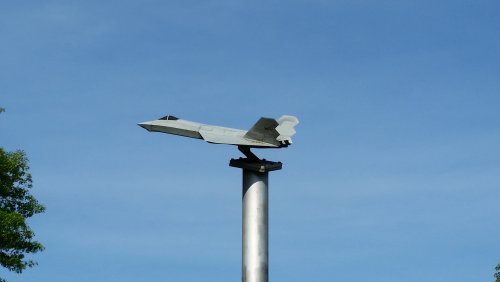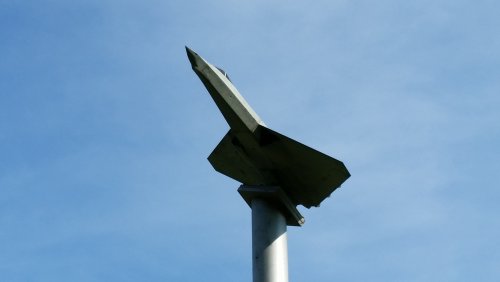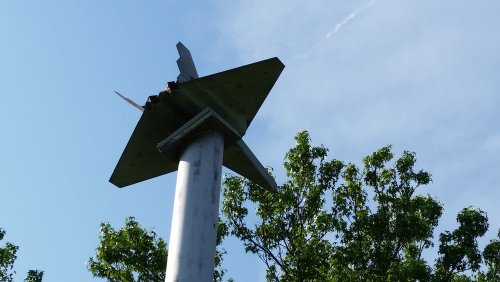You are using an out of date browser. It may not display this or other websites correctly.
You should upgrade or use an alternative browser.
You should upgrade or use an alternative browser.
NATF: planned Navy versions of the F-22 and F-23
- Thread starter Maki
- Start date
Were you the winner of it?
Is nice!
- Joined
- 31 May 2009
- Messages
- 1,154
- Reaction score
- 674
aim9xray said:Nope, found out about it after the close. *sigh *
Same here. Some unclean words may have been spoken in the process.
circle-5 said:aim9xray said:Nope, found out about it after the close. *sigh *
Same here. Some unclean words may have been spoken in the process.
You too?
- Joined
- 11 March 2006
- Messages
- 8,625
- Reaction score
- 3,805
It's the layout we know from the first picture in that thread http://www.secretprojects.co.uk/forum/index.php/topic,19374.0.html,
isn't it ?
isn't it ?
Bruno Anthony
I miss the Cold War
- Joined
- 5 August 2012
- Messages
- 635
- Reaction score
- 639
May 7, 1991 Testimony before the Senate Armed Services Committee:
"Admiral Dunleavy. I will answer that for the record later on because I do not have it off the top of my head.
[The information follows:]
The NATF's internal payload was 4AAAM/AMRAAM, 2 AIM-9, AND 500 RDS 20MM. No external load was mandated, but provision for external carriage of weapons was desired.
[Deleted.]"
"Admiral Dunleavy. I will answer that for the record later on because I do not have it off the top of my head.
[The information follows:]
The NATF's internal payload was 4AAAM/AMRAAM, 2 AIM-9, AND 500 RDS 20MM. No external load was mandated, but provision for external carriage of weapons was desired.
[Deleted.]"
- Joined
- 3 October 2007
- Messages
- 1,960
- Reaction score
- 1,197
Bruno Anthony said:May 7, 1991 Testimony before the Senate Armed Services Committee:
"Admiral Dunleavy. I will answer that for the record later on because I do not have it off the top of my head.
[The information follows:]
The NATF's internal payload was 4AAAM/AMRAAM, 2 AIM-9, AND 500 RDS 20MM. No external load was mandated, but provision for external carriage of weapons was desired.
[Deleted.]"
Given the difference in size between AAAM and AMRAAM, I wonder if the payload with the AIM-120C would have been six. I don't remember if the development ongoing with the AIM-120C had yet reached the point of public disclosure when ADM Dunleavy gave hist testimony.
hesham said:
That 1/20 scale NATF model in the first picture in post 158 and in post 111 is pretty familiar. I may or may not have built it in the late 1980s with a couple of my coworkers...
Colonial-Marine
UAVs are now friend, drones are the real enemy.
- Joined
- 5 October 2009
- Messages
- 1,471
- Reaction score
- 1,323
That model reminds me how the Lockheed NATF was a lot better looking than their A/F-X. What is that quote about the A-7 Corsair II? "Looks like somebody stepped on the blueprints of the F-8." Something similar seems to have happened with those two designs.
Meanwhile with Northrop, I simply have no idea how they took the F-23 design and ended up with their ugly looking NATF configuration. Couldn't they have met Navy requirements without resorting to such a drastic redesign?
And yes I know looks aren't important in the end, but I can still admire an aesthetically pleasing design.
Meanwhile with Northrop, I simply have no idea how they took the F-23 design and ended up with their ugly looking NATF configuration. Couldn't they have met Navy requirements without resorting to such a drastic redesign?
And yes I know looks aren't important in the end, but I can still admire an aesthetically pleasing design.
Colonial-Marine said:And yes I know looks aren't important in the end, but I can still admire an aesthetically pleasing design.
After the Air Force chose the F22, one of its generals repeated the old adage in reference to the final decision "If it looks right it will fly right".
Did the Northrop design suddenly become F22-like following the ATF selection? The Northrop ATF team must have gone ballistic when they heard that quote....
Bruno Anthony
I miss the Cold War
- Joined
- 5 August 2012
- Messages
- 635
- Reaction score
- 639
F-14D said:Bruno Anthony said:May 7, 1991 Testimony before the Senate Armed Services Committee:
"Admiral Dunleavy. I will answer that for the record later on because I do not have it off the top of my head.
[The information follows:]
The NATF's internal payload was 4AAAM/AMRAAM, 2 AIM-9, AND 500 RDS 20MM. No external load was mandated, but provision for external carriage of weapons was desired.
[Deleted.]"
Given the difference in size between AAAM and AMRAAM, I wonder if the payload with the AIM-120C would have been six. I don't remember if the development ongoing with the AIM-120C had yet reached the point of public disclosure when ADM Dunleavy gave hist testimony.
Your point brings up another question F-14D. Which AAAM are they talking about?
- Joined
- 3 October 2007
- Messages
- 1,960
- Reaction score
- 1,197
Bruno Anthony said:F-14D said:Bruno Anthony said:May 7, 1991 Testimony before the Senate Armed Services Committee:
"Admiral Dunleavy. I will answer that for the record later on because I do not have it off the top of my head.
[The information follows:]
The NATF's internal payload was 4AAAM/AMRAAM, 2 AIM-9, AND 500 RDS 20MM. No external load was mandated, but provision for external carriage of weapons was desired.
[Deleted.]"
Given the difference in size between AAAM and AMRAAM, I wonder if the payload with the AIM-120C would have been six. I don't remember if the development ongoing with the AIM-120C had yet reached the point of public disclosure when ADM Dunleavy gave hist testimony.
Your point brings up another question F-14D. Which AAAM are they talking about?
Both of them. Since the AIM-152 contractor had not yet been selected, Navy would have told the NATF contractors the 3D box in which the AAAM would have to "fit" and where the interface ports would have been located, taken from the specifications the Navy provided to the bidders for AAAM. Navy had specified that AAAM would have to be adesigned so that it could be mounted and launched from any aircraft that could use AIM-7. So, NATF woiuld have to be able to mate up with that, and that would size the internal bay and launching mechanism.
Bruno Anthony
I miss the Cold War
- Joined
- 5 August 2012
- Messages
- 635
- Reaction score
- 639
Sorry F-14D I didn't phrase my question correctly. I meant how many of each AAAM since one was smaller than the other.
- Joined
- 3 October 2007
- Messages
- 1,960
- Reaction score
- 1,197
Bruno Anthony said:Sorry F-14D I didn't phrase my question correctly. I meant how many of each AAAM since one was smaller than the other.
Actually, with the information we have available, there's no way to tell. That's because we don't know the size of the NATF weapons bay, nor the launcher arrangements of the two designs. Additionally, although one missile was smaller than the other, it was stored inside a launch tube for carriage. How that would be adapted to an internal bay could change the actual size it needed. Would the whole tube be extended? Would an internal carriage version be redesigned to not require the tube? Those factors could change the dynamics of how it is carried. The other missile seemed to be more compatible with internal carriage, but I'm sure both could do it (they'd have to). So all we can really say for sure is that the NATF would have to be able to carry at least four of either design.
Bruno Anthony
I miss the Cold War
- Joined
- 5 August 2012
- Messages
- 635
- Reaction score
- 639
That cleared it up F-14D.
RadicalDisconnect
Anthony Foulke
- Joined
- 28 April 2014
- Messages
- 212
- Reaction score
- 129
F-14D, given all the advantages of modern VG wings that you've listed, are there any reasons not to use them other than perhaps cost?
- Joined
- 2 August 2006
- Messages
- 3,255
- Reaction score
- 1,527
RadicalDisconnect said:F-14D, given all the advantages of modern VG wings that you've listed, are there any reasons not to use them other than perhaps cost?
Complexity, which equals cost. Also, a VG wing gives away your energy state to your opponent. As with everything in aircraft design, there is always a trade off. Given the fact that the USN likes the ability to loiter at a distance from the fleet, the advantages of the VG wing may offset the drawbacks. Note that Lockheed thought it was the best solution for their NATF, but the N-Mac team thought they could meet the requirements with a fixed trapezoidal wing.
_Del_
I really should change my personal text... Or not.
- Joined
- 4 January 2012
- Messages
- 1,315
- Reaction score
- 1,812
RadicalDisconnect said:F-14D, given all the advantages of modern VG wings that you've listed, are there any reasons not to use them other than perhaps cost?
It's hard to get the advantages of planform alignment when the planform is changing. Weight, complexity/reliability, cost. I'm sure all those play a part in the decision.
Colonial-Marine
UAVs are now friend, drones are the real enemy.
- Joined
- 5 October 2009
- Messages
- 1,471
- Reaction score
- 1,323
Maybe the pilot would have an option to lock the wing-sweep at the angle where the aircraft presents the lowest radar cross section possible. You'd probably use that for BVR combat with other fighters. Once you're in WVR or if you're intercepting bombers you could just switch back to the automatic setting.
Kartek
I really should change my personal text
- Joined
- 10 December 2013
- Messages
- 19
- Reaction score
- 1
Take note that only Sukhoi ever built "another" VG aircraft model, all the other metal benders ( and every American company built one or a mock-up ) gave up after thier first try. Too complex vis a vis maintenance, poor reliability, maximized cost and higher weight with few real world benefits.
- Joined
- 11 March 2006
- Messages
- 8,625
- Reaction score
- 3,805
Fighter sized VG aircraft, that were/are in service use:
GD F-111
Grumman F-14
Sukhoi Su-17/22
Sukhoi Su-24
MiG 23/27
Panavia Tornado
More than just two and besides teething troubles, I don't think, that there were
too much problems in service with regards to maintainability. If comparable performance
could have been reached with fixed wings is another story.
Edited to add the most famous of all VG types !
GD F-111
Grumman F-14
Sukhoi Su-17/22
Sukhoi Su-24
MiG 23/27
Panavia Tornado
More than just two and besides teething troubles, I don't think, that there were
too much problems in service with regards to maintainability. If comparable performance
could have been reached with fixed wings is another story.
Edited to add the most famous of all VG types !
- Joined
- 4 May 2008
- Messages
- 2,439
- Reaction score
- 762
VG buys its way onto the aircraft anytime you have to live in EXTREMELY different corners of the flight envelope.
Fixed geometry simply will not allow you to do high-speed low altitude penetration AND economic high-altitude loiter, just to pick examples. In the conceptual design phase you analyse typical mission profiles and trade weight and complexity. If the requirements are really that far apart, then VG is not necessarily heavier; hell, it may be the only solution.
The fact that no manufacturer has bothered to do more than two VG airplanes in a row is more a reflection of changing mission requirements than "fashion" or technology.
Fixed geometry simply will not allow you to do high-speed low altitude penetration AND economic high-altitude loiter, just to pick examples. In the conceptual design phase you analyse typical mission profiles and trade weight and complexity. If the requirements are really that far apart, then VG is not necessarily heavier; hell, it may be the only solution.
The fact that no manufacturer has bothered to do more than two VG airplanes in a row is more a reflection of changing mission requirements than "fashion" or technology.
Kartek
I really should change my personal text
- Joined
- 10 December 2013
- Messages
- 19
- Reaction score
- 1
Like I said, two from Sukhoi.Jemiba said:Fighter sized VG aircraft, that were/are in service use:
GD F-111
Sukhoi Su-17/22
Sukhoi Su-24
MiG 23/27
Panavia Tornado
More than just two and besides teething troubles, I don't think, that there were
too much problems in service with regards to maintainability. If comparable performance
could have been reached with fixed wings is another story.
Even McAir built a mock-up of a VG, but all of them gave up after one try, there's no mission need for both coffin corners.
- Joined
- 3 October 2007
- Messages
- 1,960
- Reaction score
- 1,197
AeroFranz said:VG buys its way onto the aircraft anytime you have to live in EXTREMELY different corners of the flight envelope.
Fixed geometry simply will not allow you to do high-speed low altitude penetration AND economic high-altitude loiter, just to pick examples. In the conceptual design phase you analyse typical mission profiles and trade weight and complexity. If the requirements are really that far apart, then VG is not necessarily heavier; hell, it may be the only solution.
The fact that no manufacturer has bothered to do more than two VG airplanes in a row is more a reflection of changing mission requirements than "fashion" or technology.
This is pretty much what I would have said had I got back here in time, so now, if you'll permit me, I'll philosophize in my usual unnecessarily wordy style regarding Radical's question.
VG does introduce complexity, but it can add a lot of capability. While a vg wing may not completely match the performance of a fixed wing at the fw's optimum point, it can offer very good performance over a larger speed because it has a larger "sweet spot". It can enhance loiter, as Sundog mentioned but it offers a lot more. like everything else in aviation, wing is a series of compromises necessary to be functional over a particular range. A wing optimized for high speed flight, such as an SR-71 is going to of necessity have poor low speed performance. Similarly, an A-10 wing is going to give you all kinds of trouble at the high subsonic, let alone supersonic, levels. With VG you can take a basic wing design, sweep it aft for higher speeds and then forward for good performance at lower speed performance without having to go to an incredibly complex design or high angle of attack for slowest speeds. That's one of the big reasons all the competitors except North American bidding for what would be my namesake (you forgot that one, Jemiba!) went for vg. It's also why you see the B-1, TU-22M and TU-160 use vg. It allows them to optimize for a high speed low drag platform and yet still have acceptable airfield performance.
In the case of the Tomcat, it also was used to give it good maneuverability over a larger speed range., Although it can't match the Hornet's high AoA performance at low speeds (although until the F-22 the Hornet was the only fighter that had better high AoA performance), it does well slow and as speed picks up it re-optimizes the wing planform for better performance over a larger range. And, the F-14 could come aboard the boat slower. That re-optimizing helps throughout the envelope. That's why the primary mode of wing sweep is full auto (based on speed, power and what the a/c is doing at the moment), a characteristic only shared by the Tornado F3, and even there it doesn't do it as well. The vg also allows it to become essentially a pure delta, with the consequent dramtic lowering of wing loading as the lifting body tunnel comes into play. Frankly, to build a fixed wing in the '70s and '80s that had as much versatility as the Tomcat's would have been heavier than a vg. The downside of the full auto wing is that close in, its position and movement telegraphs what the Tomcat is about to do to those who have studied the a/c. I think that's what you meant, Sundog, about giving away your energy state. I just prefer to express it this way because the wing can move for reasons other than just energy state. Again, I'm referring to the F-14 because it's the one that uses wing position as a maneuvering device.
It seems that nowadays we aren't asking to optimize over such a large range. VG also is harder "to stealth". The B-2 lumbers compared to the B-1, but agility was not a driver for it relative to the former. It can still be done, it's just harder. For example, in Lockheed's vg design for the late, lamented A/FX program they were willing to trade of some of the agility of the Navy version for more stealth in the Air Force version.
Nowadays, whether through more advanced technology, changing design philosophies (carry a ton of fuel, have gobs of power or in the case of USAF assume you'll always have 8,000 ft. of runway and a golf course
RadicalDisconnect
Anthony Foulke
- Joined
- 28 April 2014
- Messages
- 212
- Reaction score
- 129
Thanks for the response. I think I read somewhere that until the appearance of the Block 52 F-16s, the F-14s were the best accelerating American aircraft in the supersonic region.
M
MilwaukeeRoad
Guest
You certainly mean best accelerating American aircraft in the supersonic region? Same goes for the remak above on F-18's AoA capacility: it was the best of American fighters at that time. In both cases, those US designs were in fact surpassed by non-American designs at that time.RadicalDisconnect said:Thanks for the response. I think I read somewhere that until the appearance of the Block 52 F-16s, the F-14s were the best accelerating aircraft in the supersonic region.
RadicalDisconnect
Anthony Foulke
- Joined
- 28 April 2014
- Messages
- 212
- Reaction score
- 129
MilwaukeeRoad said:You certainly mean best accelerating American aircraft in the supersonic region? Same goes for the remak above on F-18's AoA capacility: it was the best of American fighters at that time. In both cases, those US designs were in fact surpassed by non-American designs at that time.RadicalDisconnect said:Thanks for the response. I think I read somewhere that until the appearance of the Block 52 F-16s, the F-14s were the best accelerating aircraft in the supersonic region.
Yes, that's what I meant.
- Joined
- 9 October 2009
- Messages
- 21,973
- Reaction score
- 13,631
FighterJock
ACCESS: Above Top Secret
- Joined
- 29 October 2007
- Messages
- 5,607
- Reaction score
- 5,936
Who thinks that NATF was an opportunity lost when it was canceled.
- Joined
- 9 October 2009
- Messages
- 21,973
- Reaction score
- 13,631
FighterJock said:Who thinks that NATF was an opportunity lost when it was canceled.
I don't think anyone would dispute that at this stage.
XP67_Moonbat
ACCESS: Top Secret
- Joined
- 16 January 2008
- Messages
- 2,271
- Reaction score
- 543
Agreed.
Colonial-Marine
UAVs are now friend, drones are the real enemy.
- Joined
- 5 October 2009
- Messages
- 1,471
- Reaction score
- 1,323
Considering the limited production run of F-22s I have my doubts the NATF would have even made it to that stage.
Airplane
ACCESS: Secret
- Joined
- 3 October 2015
- Messages
- 433
- Reaction score
- 55
I found this monument by McD (Boeing) to the workers on the ATF program. It looks like the Navalized variant of the NG YF-23 (minus the canards). Is this a previously unknown McD design?
http://oppositelock.kinja.com/yf-23-wind-tunnel-model-1778301346


http://oppositelock.kinja.com/yf-23-wind-tunnel-model-1778301346
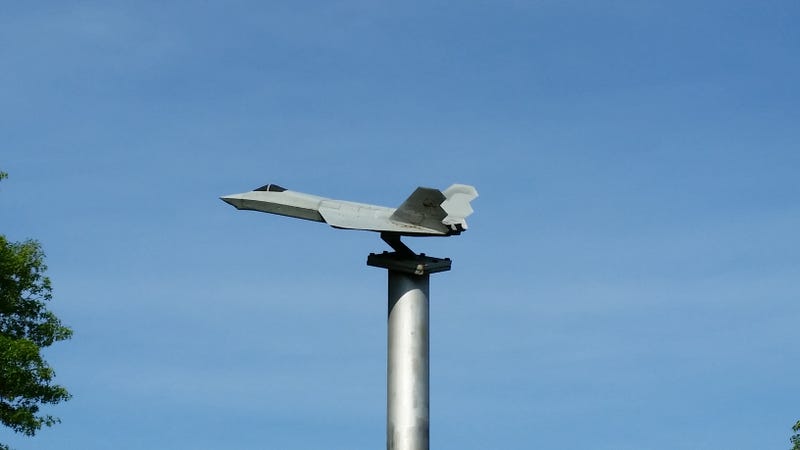
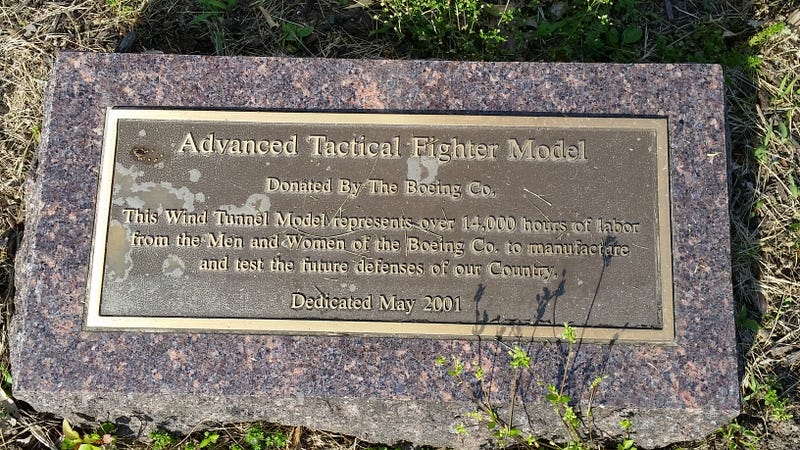
- Joined
- 27 December 2005
- Messages
- 17,748
- Reaction score
- 26,420
Its definitely a model of the Northrop / McDonnell NATF without canards. There were various iterations of the NATF design. Good find!
Its in the St Louis suburb of Bellefontaine Neighbors - who lives near and owns a camera?????
Its in the St Louis suburb of Bellefontaine Neighbors - who lives near and owns a camera?????
Attachments
- Joined
- 9 October 2009
- Messages
- 21,973
- Reaction score
- 13,631
Regarding the Northrop / McDonnell Douglas NATF: http://www.secretprojects.co.uk/forum/index.php/topic,28617.0.html
Similar threads
-
-
FLIGHTS OF FANTASY: The Boeing/Lockheed A/FX
- Started by Sentinel Chicken
- Replies: 52
-
-
-
Advanced Tactical Support Aircraft (ATSA) US Navy
- Started by dauby09
- Replies: 22

